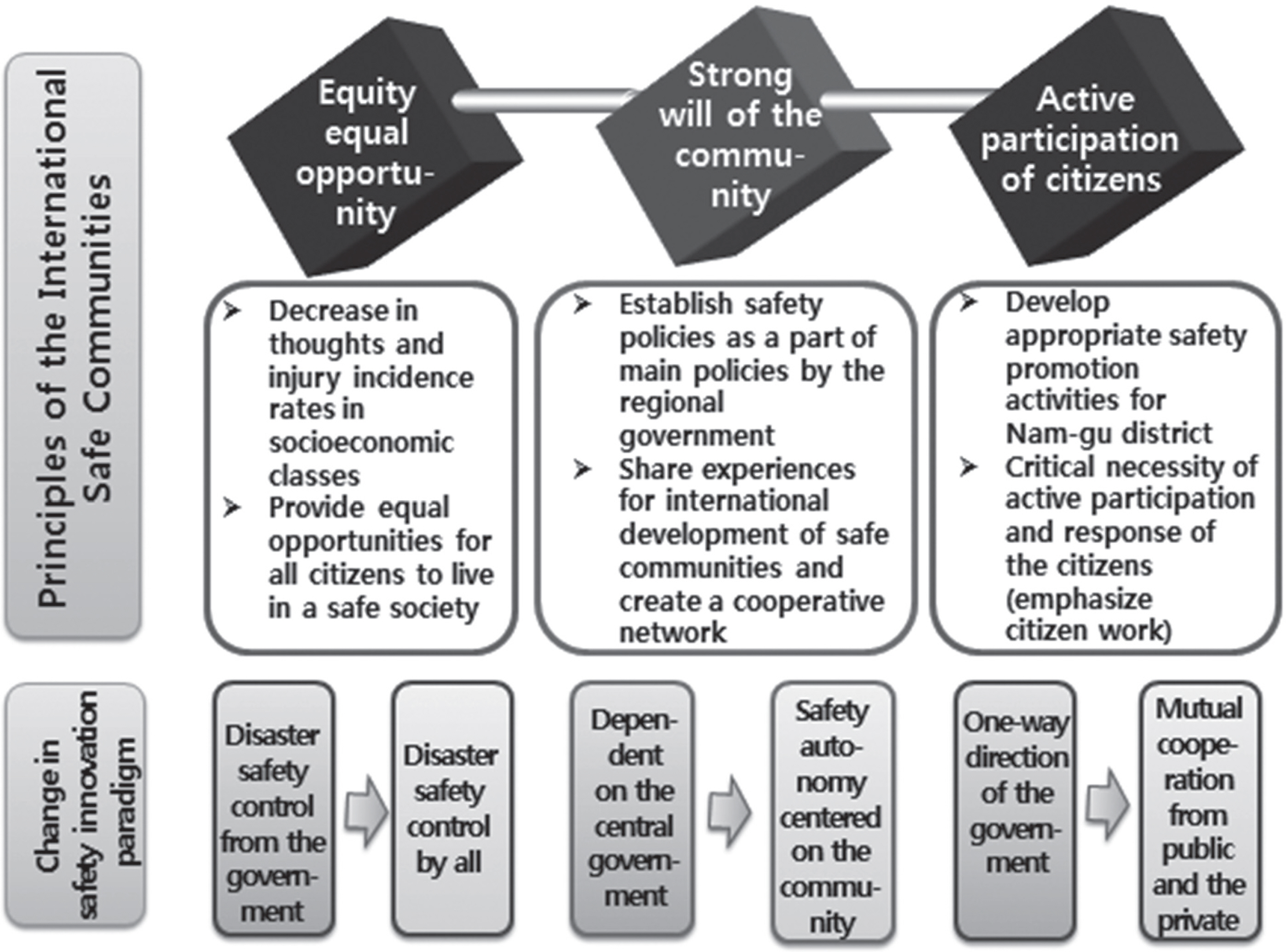J Korean Acad Nurs.
2015 Dec;45(6):910-918. 10.4040/jkan.2015.45.6.910.
Application and Developmental Strategies for Community-Based Injury Prevention Programs of the International Safe Communities Movement in Korea
- Affiliations
-
- 1Department of Nursing, Inje University, Busan, Korea. jibai@inje.ac.kr
- 2Department of Emergency Medicine, Medical School, Aju University, Suwon, Korea.
- 3Department of Rehabilitation Science, Graduate School, Inje University, Busan, Korea.
- 4Department of Nursing, Graduate School, Inje University, Busan, Korea.
- 5Department of Molecular Biology, Busan National University, Busan, Korea.
- 6Department of English Language and Literature, Seoul National University, Seoul, Korea.
- KMID: 2363114
- DOI: http://doi.org/10.4040/jkan.2015.45.6.910
Abstract
- PURPOSE
Safety of humans is an important factor that affects health overall, and injuries are one of the major public-health problems in the world. The purposes of this study were to describe the International safe Community movement which contributes to the injury prevention and safety promotion all over the world, and to identify out the application and developmental strategies for Korea.
METHODS
A review was done of previous research, reviews, and reports on the history, concepts, basic principles, and recommendations for actions of the Safe Community.
RESULTS
For this study, the application strategies of the International Safe Community movement in Korea were examined to deduce the strengths of the safe Community program. Community-based injury prevention work according to the International Safe Community model is a successful and cost-effective way of reducing injuries in the community.
CONCLUSION
Through the International Safe Community program, communities are able to realize a healthy community and achieve improved quality of lives for the people, which is the ultimate objective of the Safe Community model. In addition, it will contribute to the economic vitalization and gain through energy and enhancement of productivity of people.
MeSH Terms
Figure
Reference
-
References
1. Svanström L, Haglund BJA. Evidence-based safety promotion and injury prevention-an introduction [Internet]. Stockholm, SE: Karolinska Institutet;2000. [cited 2015 October 12]. Available from:. http://www.ki.se/csp/pdf/Books/EvidenceBasedSkadepre-vEngvers.pdf.2. Jansson B. Festschrift in honour a safe community-a tribute to Leif Svanström. International Journal of Injury Control and Safety Promotion. 2012; 19(3):189–191. http://dx.doi.org/10.1080/17457300.2012.709724.3. Kendrick D, Young B, Mason-Jones AJ, Ilyas N, Achana FA, Cooper NJ, et al. Home safety education and provision of safety equipment for injury prevention (Review). Evidence-Based Child Health. 2013; 8(3):761–939. http://dx.doi.org/10.1002/ebch.1911.
Article4. World Health Organization. Human factors in patient safety review of topics and tools [Internet]. Geneva, CH: Author;2009. [cited 2015 October 12]. Available from:. http://www.who.int/patient-safety/research/methods_measures/human_factors/human_factors_review.pdf.5. Welander G, Svanström L, Ekman R. Safety promotion-an introduction. 2nd ed. Stockholm, SE: Karolinska Institutet;2004.6. World Health Organization Collaborating Centre on Community Safety Promotion. How do we define a safe community? [Internet]. Stockholm, SE: Karolinska Institutet;2004. [cited 2009 August 16]. Available from:. http://www.phs.ki.se/csp/who_intro-duction_en.htm.7. Mitchell R, Haddrill K. WHO safe communities-should we expand the definition of a ‘community’? International Journal of Injury Control and Safety Promotion. 2007; 14(1):60–63. http://dx.doi.org/10.1080/17457300600775585.
Article8. Nilsen P, Bourne M, Coggan C. Using local injury surveillance for community-based injury prevention: An analysis of Scandinavian WHO safe community and Canadian safe community foundation programmes. International Journal of Injury Control and Safety Promotion. 2007; 14(1):35–43. http://dx.doi.org/10.1080/17457300600864447.
Article9. Jansson B. Research on the prevention of fall injuries still makes prediction for practice difficult. Age and Ageing. 2007; 36(3):351–352. http://dx.doi.org/10.1093/ageing/afm027.
Article10. McClure RJ. Injury risk and prevention in context. Injury Prevention. 2010; 16(6):361–362. http://dx.doi.org/10.1136/ip.2010.028175.
Article11. Seedat M, McClure R, Suffla S, van Niekerk A. Developing the evidence-base for safe communities: A multi-level, partly randomised, controlled trial. International Journal of Injury Control and Safety Promotion. 2012; 19(3):231–241. http://dx.doi.org/10.1080/17457300.2012.705303.
Article12. World Health Organization. The Adelaide recommendations: Healthy public policy. Health Promotion International. 1988; 3(2):183–186. http://dx.doi.org/10.1093/heapro/3.2.183.13. World Health Organization. Ottawa charter for health promotion. Health Promotion International. 1986; 1(4):405. http://dx.doi.org/10.1093/heapro/1.4.405-a.14. World Health Organization Collaborating Centre on Community Safety Promotion. Manifesto for safe communities. Paper presented at The First World Conference on Accident and Injury Prevention. 1989. September 17-20; Stockholm, Sweden.15. Svanström L. Evidence-based injury prevention and safety promotion: Some results. A chapter in the Report: Evidence-based injury prevention and safety promotion and Slutrapporten: Samh llets oly-cksbarn. F rslag till nationella j mlikhetsstrategier –lera skadefria r f r alla. Stockholm, SE: Sweden’s National Institute of Public Health;1998.16. Butterfoss FD. Process evaluation for community participation. Annual Review of Public Health. 2006; 27:323–340. http://dx.doi.org/10.1146/annurev.publhealth.27.021405.102207.
Article17. Svanström L. It all started in Falk ping, Sweden: Safe Communities-global thinking and local action for safety. International Journal of Injury Control and Safety Promotion. 2012; 19(3):202–208. http://dx.doi.org/10.1080/17457300.2012.696661.18. Ekman R, Ekman DS, Schyllander J, Schelp L. A comparison of unintentional injury patterns occurring in two Swedish communities in 1978 and in 2008. International Journal of Injury Control and Safety Promotion. 2015; 22(3):254–259. http://dx.doi.org/10.1080/17457300.2014.918153.
Article19. Rahim Y. Safe community in different settings. International Journal of Injury Control and Safety Promotion. 2005; 12(2):105–112. http://dx.doi.org/10.1080/17457300500089954.
Article20. Lindqvist K. Motala municipality-a sustainable safe community in Sweden. International Journal of Injury Control and Safety Promotion. 2012; 19(3):249–259. http://dx.doi.org/10.1080/17457300.2012.692692.
- Full Text Links
- Actions
-
Cited
- CITED
-
- Close
- Share
- Similar articles
-
- Impact of Community-Based Approach as Policy Tool: World Health Organization-Designated Safe Communities of Korea and Health Action Zones of the United Kingdom
- Development of a Community-based Participatory Global Health Project Model for Primary Health Care Capacity Development: A Case Study from a Rural Community in Ecuador
- Osteoporosis prevention and osteoporosis exercise in community-based public health programs
- Ecological Factors and Strategies for Childhood Obesity Prevention Targeting Vulnerable Children: Using Community-Based Participatory Research
- Development and Application of a Community-based Meal Program Model for the Elderly in Rural Area



